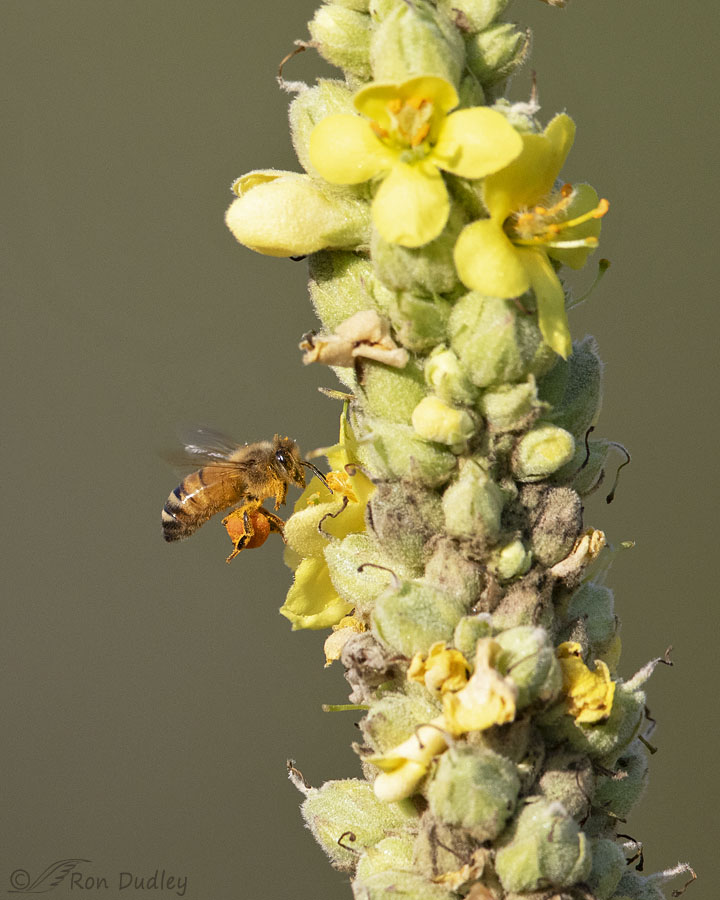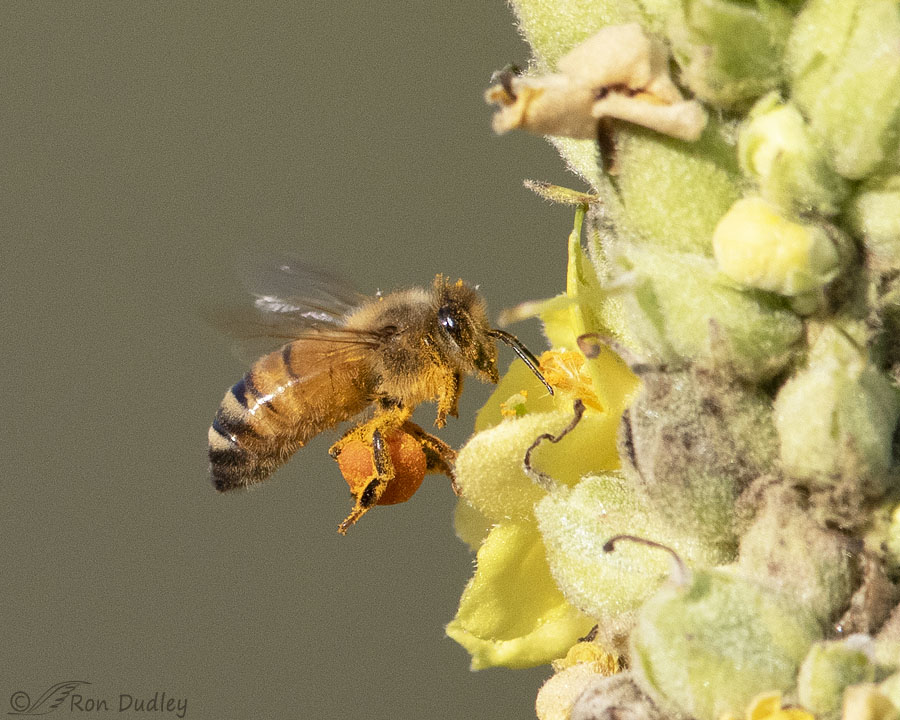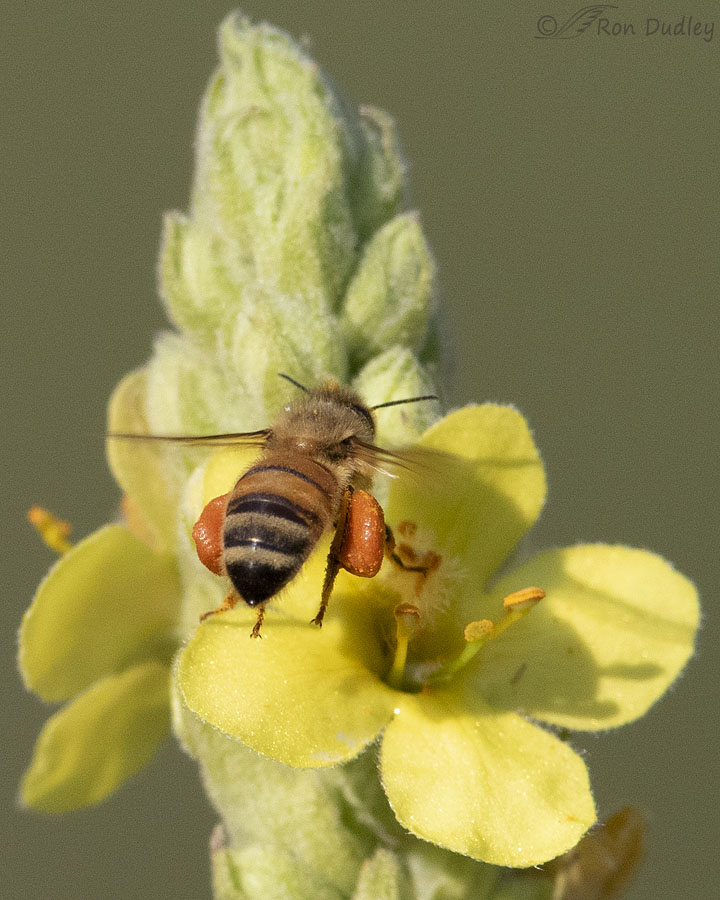I wasn’t impressed with most of the bird photos I took yesterday morning but I thought these honey bee photos were pretty interesting.

1/4000, f/5.6, ISO 800, Canon 7D Mark II, Canon EF 500mm f/4L IS II USM + EF 1.4 III Extender
I’d actually been trying to photograph chickadees on the Common Mullein spikes but I could never get any clear shots of them. It was then that I noticed this honey bee with her pollen baskets (corbicula) so full as to almost look like she was carrying basketballs between her legs. Honey bees can carry up to half their own weight in pollen in their baskets and this industrious little lady was certainly pushing that limit.

Not only were her baskets full to overflowing, much of her body was covered with pollen including her compound eyes. As one whose eyes are extremely sensitive to even the tiniest bit of foreign matter, just looking at this photo makes my eyes water.

1/5000, f/5.6, ISO 800, Canon 7D Mark II, Canon EF 500mm f/4L IS II USM + EF 1.4 III Extender
It may not look like it but this is the same bee just a few seconds later. This perspective gives us a look at both baskets and the original source of the pollen – the anthers at the ends of the long filaments of the flower’s stamens.
Honey bees moisten the dry pollen as it’s being packed into the baskets. Moistening the pollen changes its color which accounts for the different color of the pollen in the baskets as compared to its color on the anthers. The color of the pollen in the baskets can actually help identify its original source.
Yeah I know, for most of my readers there’s nothing new here. Every school kid learned (or should have learned) about honeybees as a student. But I think it’s interesting to see the small details documented in quality photos that can be carefully perused.
Bees and other pollinators – what would we do without them?
Ron


I love the photos, it is amazing how much they can pack on and still fly.
Thanks, April.
I have a question for those of you out there smarter than yours truly, which would be most everyone.
Why is “pollinator” correct and not “pollenator”? After all it’s pollen, not pollin…
Not knowing Latin, as near as I can figure is that pollen is the substance and pollin- is the combining form. Perhaps more by convention than any strict linguistic rule. I’ll go ask one of my Latin friends. Oh wait, they’re all dead.
I should probably say “one of my native Latin speaking friends”.
You’re probably right, Lyle – the combining form.
What would we do without the pollinators? Die probably.
As always, thank you and your knowledgeable commentators. Pollen hog is a new term to me, but I can see exactly where it comes from.
“What would we do without the pollinators? Die probably”
Probably. If not from starvation, from the economic and social upheaval.
We are already to the upheaval stage.
Wow! I have seen (and taken) lots of pollen basket shots but I have never seen baskets this full and this large. Must have been quite the fun, exciting time to watch and capture this. Silver linings and all that!
Must have been quite the fun, exciting time to watch and capture this. Silver linings and all that!
Pat, I don’t think I’ve seen any bigger pollen baskets than these. That’s what got my attention when I was really looking for birds.
What a coincidence. I just learned about corbiculae in a pollinator class I took a few weeks ago, though no mention of the pollen moistening, or remarkable photos like this.
The recently arrived and dreaded honey bee-killing Asian giant hornet was first spotted about 11 miles from here last October and again about 2 weeks ago. Despite the hundreds of traps, both sightings that led to locating nests (radio tagging hornets) were not in traps. They go after paper wasps, too, which I have lots of, so I check those regularly.
Interestingly, I see more bumblebees than honey bees in my yard. Perhaps because there are so many native plants, or few hives nearby, or both.
Lyle, I see fewer honey bees in my yard than I used to. I read recently that in 2019 alone 40% of all honey bee colonies in the US perished.
The honey bee industry rebuilds its stock of honey bees every year. It is the native bees that are in dire need of support.
https://www.scientificamerican.com/article/the-problem-with-honey-bees/
Well Ron… You’ve done it again. Bees and their baskets are new to me and if they taught this in school, I missed that day. Love zooming in and looking at ever little detail

I can’t wait to look up more info about this later
Diana, looking up more info on them should be pretty interesting for you. I’ve only scratched the surface here – they’re fascinating creatures.
I’m glad that you posted these photos–I had no idea that they could carry so much pollen in 1 trip, or that they were so systematic ( moistening the bundle)
about it. Also, your posse contributes such interesting side-notes, such as the
idea that honeybees could be a harbinger of Anglo invasion into a new ( for Anglos ) area……I look forward to “Feathered Photography” every morning for
both beauty and education !
Thanks very much, Kris. What would we do without pollinators and my ‘posse’?
This industrious lady is — removes sunglasses — “busy as a bee.” Sorry. I couldn’t resist.
Sorry. I couldn’t resist.
Marty, the official State Symbol of Utah is the beehive. Mormons take that industriousness seriously.
Marty and Ron, you may be interested in this take on the beehive state’s industriousness:
https://www.sltrib.com/opinion/commentary/2019/12/07/thomas-meinzen-beehive/
Interesting post and excellent photos of the Honey Bees. I have always enjoyed watching them at work. Those baskets remind me of the orange tennis balls I often used years ago. Another interesting and informative biology lesson from our retired teacher.
Thank you, Everett.
As much as we need them and love them…..Some native American tribes considered Honey Bees to be harbingers of disaster. Wherever Honey Bees showed up, White Men followed soon after.
Interesting historical note, Porcupine.
I thank you and the commenter who shared that honeybees are non-native species, and thus imperil some of the native populations. Given the productivity of native bees like the mason bees, I can understand is that the “honeybee crisis” fails to address larger questions.
Unceasing inquiry into the ecology of the earth in service of “walking in balance” is clearly one of life’s imperatives. I am grateful to you both.
‘Stuff’ gets complicated doesn’t it Allison.
Thx for the tutorial! Knew they carried a LOT and have watched them trying to squeeze through 1/4″ mesh covering most of the entry to their hive in our old shack. Wondered why they weren’t “losing” it in the effort – moistening it explains that.
Great Blue Heron working the puddles on the creek this morning – things getting tough for them when they start doing that here…
Thanks, Judy. Thankfully, Great Blue Herons are extremely resourceful (around here some of them stay all winter and feed on voles when ponds freeze over) but it’s still gotta be tough for them in your area right now.
Yes – amazing, but honey bees are non-native to the U.S. The effects of permitting even one beehive on Forest Service or BLM lands are consequential for native bees because one average-sized honey bee hive extracts enough pollen in one month to support the development of 33,000 native bees.(James H. Cane & Vincent J. Tepedino, Gauging the Effect of Honey Bee Pollen Collection on Native Bee Communities, 10 CONSERVATION LETTERS 205, 205–10 (2017).)
Hundreds of hives are permitted on mid-elevations off of Highway 89 up Logan Canyon on the Logan Ranger District (Forest Service), all with access to productive native tall forb communities (habitat of native bees).
See http://www.projectelevenhundred.org
There is a reason one native bee entomologist refers to honey bees as “pollen hogs.”
Well, I certainly wouldn’t dispute that they’re “pollen hogs”, as illustrated by this particular bee.